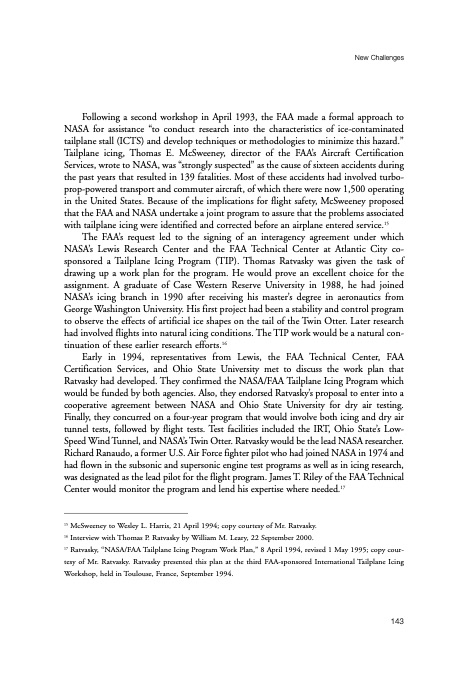
PDF Publication Title:
Text from PDF Page: 154
Following a second workshop in April 1993, the FAA made a formal approach to NASA for assistance “to conduct research into the characteristics of ice-contaminated tailplane stall (ICTS) and develop techniques or methodologies to minimize this hazard.” Tailplane icing, Thomas E. McSweeney, director of the FAA’s Aircraft Certification Services, wrote to NASA, was “strongly suspected” as the cause of sixteen accidents during the past years that resulted in 139 fatalities. Most of these accidents had involved turbo- prop-powered transport and commuter aircraft, of which there were now 1,500 operating in the United States. Because of the implications for flight safety, McSweeney proposed that the FAA and NASA undertake a joint program to assure that the problems associated with tailplane icing were identified and corrected before an airplane entered service.15 The FAA’s request led to the signing of an interagency agreement under which NASA’s Lewis Research Center and the FAA Technical Center at Atlantic City co- sponsored a Tailplane Icing Program (TIP). Thomas Ratvasky was given the task of drawing up a work plan for the program. He would prove an excellent choice for the assignment. A graduate of Case Western Reserve University in 1988, he had joined NASA’s icing branch in 1990 after receiving his master’s degree in aeronautics from George Washington University. His first project had been a stability and control program to observe the effects of artificial ice shapes on the tail of the Twin Otter. Later research had involved flights into natural icing conditions. The TIP work would be a natural con- tinuation of these earlier research efforts.16 Early in 1994, representatives from Lewis, the FAA Technical Center, FAA Certification Services, and Ohio State University met to discuss the work plan that Ratvasky had developed. They confirmed the NASA/FAA Tailplane Icing Program which would be funded by both agencies. Also, they endorsed Ratvasky’s proposal to enter into a cooperative agreement between NASA and Ohio State University for dry air testing. Finally, they concurred on a four-year program that would involve both icing and dry air tunnel tests, followed by flight tests. Test facilities included the IRT, Ohio State’s Low- Speed Wind Tunnel, and NASA’s Twin Otter. Ratvasky would be the lead NASA researcher. Richard Ranaudo, a former U.S. Air Force fighter pilot who had joined NASA in 1974 and had flown in the subsonic and supersonic engine test programs as well as in icing research, was designated as the lead pilot for the flight program. James T. Riley of the FAA Technical Center would monitor the program and lend his expertise where needed.17 New Challenges 15 McSweeney to Wesley L. Harris, 21 April 1994; copy courtesy of Mr. Ratvasky. 16 Interview with Thomas P. Ratvasky by William M. Leary, 22 September 2000. 17 Ratvasky, “NASA/FAA Tailplane Icing Program Work Plan,” 8 April 1994, revised 1 May 1995; copy cour- tesy of Mr. Ratvasky. Ratvasky presented this plan at the third FAA-sponsored International Tailplane Icing Workshop, held in Toulouse, France, September 1994. 143PDF Image | History of NASA Icing Research Tunnel

PDF Search Title:
History of NASA Icing Research TunnelOriginal File Name Searched:
sp4226.pdfDIY PDF Search: Google It | Yahoo | Bing
NFT (Non Fungible Token): Buy our tech, design, development or system NFT and become part of our tech NFT network... More Info
IT XR Project Redstone NFT Available for Sale: NFT for high tech turbine design with one part 3D printed counter-rotating energy turbine. Be part of the future with this NFT. Can be bought and sold but only one design NFT exists. Royalties go to the developer (Infinity) to keep enhancing design and applications... More Info
Infinity Turbine IT XR Project Redstone Design: NFT for sale... NFT for high tech turbine design with one part 3D printed counter-rotating energy turbine. Includes all rights to this turbine design, including license for Fluid Handling Block I and II for the turbine assembly and housing. The NFT includes the blueprints (cad/cam), revenue streams, and all future development of the IT XR Project Redstone... More Info
Infinity Turbine ROT Radial Outflow Turbine 24 Design and Worldwide Rights: NFT for sale... NFT for the ROT 24 energy turbine. Be part of the future with this NFT. This design can be bought and sold but only one design NFT exists. You may manufacture the unit, or get the revenues from its sale from Infinity Turbine. Royalties go to the developer (Infinity) to keep enhancing design and applications... More Info
Infinity Supercritical CO2 10 Liter Extractor Design and Worldwide Rights: The Infinity Supercritical 10L CO2 extractor is for botanical oil extraction, which is rich in terpenes and can produce shelf ready full spectrum oil. With over 5 years of development, this industry leader mature extractor machine has been sold since 2015 and is part of many profitable businesses. The process can also be used for electrowinning, e-waste recycling, and lithium battery recycling, gold mining electronic wastes, precious metals. CO2 can also be used in a reverse fuel cell with nafion to make a gas-to-liquids fuel, such as methanol, ethanol and butanol or ethylene. Supercritical CO2 has also been used for treating nafion to make it more effective catalyst. This NFT is for the purchase of worldwide rights which includes the design. More Info
NFT (Non Fungible Token): Buy our tech, design, development or system NFT and become part of our tech NFT network... More Info
Infinity Turbine Products: Special for this month, any plans are $10,000 for complete Cad/Cam blueprints. License is for one build. Try before you buy a production license. May pay by Bitcoin or other Crypto. Products Page... More Info
| CONTACT TEL: 608-238-6001 Email: greg@infinityturbine.com | RSS | AMP |